Building A Secure Future: Essential Practices For Safeguarding Your Small Business Against Cyber Threats”
Is your small business prepared to face the relentless onslaught of cyber threats? In today’s digital landscape, where hackers and cybercriminals are constantly devising new ways to infiltrate systems and steal sensitive data, it is crucial for every small business owner to take proactive measures to safeguard their company. Building a secure future for your small business requires more than just basic antivirus software or firewalls; it demands a comprehensive approach that tackles vulnerabilities head-on.
By implementing essential practices and adopting robust security measures, you can fortify your business against cyber threats and ensure the safety of your valuable information.
Imagine a world where every aspect of your small business is vulnerable to attack – from customer data and financial records to intellectual property and trade secrets. Such a scenario could spell disaster for any entrepreneur striving to build a successful venture. It is this very reality that underscores the need for stringent cybersecurity practices in today’s highly interconnected world.
As technology continues to advance at breakneck speed, so too do the tactics employed by malicious actors seeking to exploit weaknesses in security systems. Therefore, it is imperative that you equip yourself with the knowledge and tools necessary to combat these ever-evolving threats effectively.
By implementing essential cybersecurity practices tailored specifically for small businesses, you can establish a strong foundation upon which your venture can thrive securely in an increasingly digital age.
Key Takeaways
- Conduct a security assessment to identify vulnerabilities in your IT infrastructure.
- Implement strong password policies and consider using password generators and multi-factor authentication.
- Train employees on cybersecurity best practices, including phishing awareness and incident response.
- Regularly update and patch software, and implement regular vulnerability scans for proactive protection.
Conduct a Security Assessment
You should conduct a security assessment to ensure your small business is protected against cyber threats. A security assessment, also known as a security audit, involves evaluating the current state of your business’s cybersecurity measures and identifying any vulnerabilities or weaknesses that may exist.
This process typically includes conducting vulnerability scanning, which involves using specialized software to scan your systems and networks for potential vulnerabilities that could be exploited by hackers. By performing a thorough security assessment, you can gain valuable insights into the areas where your business may be at risk and take proactive steps to address these issues before they’re exploited.
During a security assessment, vulnerability scanning plays a crucial role in identifying potential weak points in your small business’s IT infrastructure. This process involves automated tools that scan your systems for known vulnerabilities and misconfigurations. These tools simulate attacks on your network to identify any gaps in security that could be exploited by malicious actors.
By regularly conducting vulnerability scans, you can stay ahead of cyber threats by identifying and patching vulnerabilities before they can be used against you.
Implementing strong password policies is an essential step towards building a secure future for your small business. Passwords are often the first line of defense against unauthorized access to sensitive data or systems within an organization. It’s important to enforce strong password requirements such as length, complexity, and expiration periods for employees’ accounts.
Additionally, consider implementing multi-factor authentication (MFA) where possible to add an extra layer of protection. By promoting good password hygiene and enforcing strong password policies across your small business, you significantly reduce the risk of unauthorized access and enhance overall cybersecurity posture.
Transitioning into the subsequent section about ‘implement strong password policies,’ it’s vital to note that conducting regular security assessments provides valuable insights into potential weaknesses within your organization’s IT infrastructure. Identifying these vulnerabilities allows you to take necessary steps towards mitigating risks effectively through techniques like implementing strong password policies.
Implement Strong Password Policies
Start by enforcing robust password policies to ensure the security of your business against online dangers. Implementing strong password policies is crucial in protecting your sensitive information and preventing unauthorized access.
One effective practice is using password generators, which create complex and unique passwords that are difficult for hackers to crack. These generators can generate passwords with a combination of upper and lowercase letters, numbers, and special characters. By using such tools, you can eliminate the risk of employees choosing weak or easily guessable passwords.
Additionally, consider implementing multi-factor authentication (MFA) as an extra layer of protection. MFA requires users to provide multiple forms of verification before gaining access to their accounts or systems. This could include entering a password along with a one-time code sent to their mobile device or answering security questions. By implementing MFA, even if an attacker manages to obtain a user’s password, they would still need additional verification factors, making it significantly harder for them to gain unauthorized access.
By incorporating these strong password policies and utilizing technologies like password generators and multi-factor authentication, you can greatly enhance the security posture of your small business against cyber threats.
However, securing your business doesn’t stop here. It’s essential to train your employees on cybersecurity best practices as well. This will ensure that they understand the importance of strong passwords and are aware of other potential risks they may encounter online while conducting business operations securely.
[Transition] Moving forward into the next section about training employees on cybersecurity best practices…
Train Employees on Cybersecurity Best Practices
To ensure the safety of your company’s sensitive information, it’s crucial to train your employees on the best practices for cybersecurity. By providing comprehensive training, you can equip your staff with the knowledge and skills necessary to identify and respond to potential cyber threats effectively.
Here are four essential areas to focus on during employee cybersecurity training:
-
Phishing Awareness: Educate your employees about the dangers of phishing attacks, which remain one of the most common methods used by hackers to gain unauthorized access. Teach them how to recognize suspicious emails or messages that may contain malicious links or attachments. Encourage them not to click on unfamiliar links or provide personal information unless they can verify the source.
-
Incident Response Training: Prepare your employees for potential security incidents by conducting regular incident response training sessions. This will help them understand their roles and responsibilities in case of a cyber attack. Train them on how to report incidents promptly, gather evidence, mitigate damage, and follow established protocols for communication and escalation.
-
Password Management: Emphasize the importance of strong password practices during your training sessions. Instruct employees to create unique passwords that are long, complex, and include a combination of letters, numbers, and special characters. Encourage them not to reuse passwords across different accounts and implement two-factor authentication where possible.
-
Security Updates: Remind employees about the significance of regularly updating and patching software systems, including operating systems, applications, firewalls, antivirus programs, etc. Explain how outdated software can leave vulnerabilities that cybercriminals may exploit easily.
By implementing these employee cybersecurity best practices within your organization’s training program, you can significantly reduce the risk of successful cyber attacks targeting your small business’ valuable data assets.
Now transitioning into ‘Regularly Update and Patch Software,’ another critical aspect in building a secure future for your small business is ensuring that all software systems are up-to-date with security patches and updates…
Regularly Update and Patch Software
Updating and patching software regularly is crucial for maintaining a strong defense against potential cyber threats. By keeping your software up to date, you ensure that any vulnerabilities or weaknesses are addressed promptly, reducing the risk of exploitation by attackers. Vulnerability scanning plays a vital role in this process, as it helps identify any existing vulnerabilities in your system that need to be patched. Regularly conducting vulnerability scans allows you to stay one step ahead of cybercriminals and proactively protect your small business.
In addition to vulnerability scanning, software maintenance is another essential practice in safeguarding your small business against cyber threats. This involves regularly updating all software applications used within your organization, including operating systems, antivirus programs, firewalls, and other security tools. These updates often include patches that fix known security issues and improve overall performance. Neglecting software maintenance can leave your business exposed to various risks and make it easier for attackers to exploit vulnerabilities.
To emphasize the importance of regular software updates and patches, consider the following table:
| Key Point | Explanation |
|---|---|
| Regular Updates | Keep all software applications up to date with the latest versions released by vendors. |
| Patch Management | Implement a robust process for evaluating and applying patches promptly across all systems. |
| Vulnerability Scanning | Conduct regular vulnerability scans to identify potential weaknesses in your system that require attention. |
| Automated Tools | Utilize automation tools designed for patch management and vulnerability scanning processes for efficiency and accuracy. |
By understanding the significance of updating and patching software regularly while incorporating effective vulnerability scanning practices into your cybersecurity strategy, you fortify your defenses against potential cyber threats effectively. However, securing your small business doesn’t stop here; backupping your data regularly and securely is equally crucial in ensuring resilience in case of an attack or system failure.
Backup Your Data Regularly and Securely
Make sure you regularly back up your data in a secure manner, as studies have shown that businesses that experience a major data loss without a backup plan in place are at risk of shutting down within six months.
Data loss can occur due to various reasons such as hardware failure, cyber attacks, or accidental deletion. To safeguard your small business against such threats, it’s crucial to implement a robust backup strategy that includes data encryption and cloud storage.
Data encryption plays a vital role in ensuring the security of your backed-up data. By encrypting your data, you convert it into an unreadable format for unauthorized individuals. This adds an extra layer of protection and prevents potential attackers from accessing sensitive information even if they manage to breach your backup system. Utilizing strong encryption algorithms will ensure that only authorized users with the decryption key can access and restore the backed-up data.
In addition to encryption, utilizing cloud storage for backing up your data offers numerous benefits. Cloud storage provides scalability and flexibility, allowing you to easily increase or decrease the allocated space based on your business needs. It also eliminates the need for physical storage devices, reducing costs associated with maintenance and hardware upgrades. Furthermore, reputable cloud service providers often employ advanced security measures like firewalls, intrusion detection systems, and regular audits to protect your stored data from unauthorized access.
By regularly backing up your data using techniques like encryption and leveraging cloud storage solutions, you significantly reduce the risk of losing critical business information due to unforeseen circumstances. Remember to periodically test the integrity of your backups by restoring them onto test environments to ensure their reliability when needed. Safeguarding your small business against potential disasters not only protects valuable assets but also instills confidence in customers who rely on you for their products or services.
Frequently Asked Questions
How can I identify potential cyber threats and vulnerabilities in my small business?
To identify potential cyber threats and vulnerabilities in your small business, you need to adopt a technical, detail-oriented, and analytical approach.
Start by conducting a thorough assessment of your network infrastructure, systems, and applications. Look for any vulnerabilities such as outdated software versions or weak passwords that can be exploited by hackers.
Implement regular security audits and penetration testing to identify potential weaknesses in your network defenses.
Additionally, educate yourself and your employees about common cyber threats like phishing attacks or malware infections so that you can recognize them when they occur.
By staying vigilant and proactively mitigating vulnerabilities, you can enhance the overall security posture of your small business.
What are some common mistakes to avoid when creating strong passwords for my business accounts?
When it comes to creating strong passwords for your business accounts, it’s important to avoid common mistakes that can compromise the security of your information. One interesting statistic is that 81% of data breaches are due to weak or stolen passwords.
To ensure password security, it is crucial to avoid using easily guessable or commonly used passwords such as ‘123456’ or ‘password.’ Instead, create complex passwords with a combination of uppercase and lowercase letters, numbers, and special characters.
Another common mistake is reusing passwords across multiple accounts, which increases the risk if one account gets compromised. Implementing two-factor authentication adds an extra layer of protection by requiring a second form of verification before accessing an account.
Additionally, regularly updating and changing your passwords will help mitigate any potential vulnerabilities. By following these password security tips and avoiding these common mistakes, you can significantly enhance the security of your business accounts and protect against cyber threats.
Are there any specific cybersecurity best practices that should be followed when using public Wi-Fi networks?
When using public Wi-Fi networks, it’s crucial to be aware of the risks associated with them. Public Wi-Fi networks are particularly vulnerable to cyber threats due to their lack of encryption and shared nature.
To ensure the security of your business accounts and sensitive information, it’s essential to follow best practices for Wi-Fi security. Firstly, avoid connecting to public Wi-Fi networks that are unsecured or don’t require a password for access. These types of networks are more susceptible to unauthorized access and interception of data.
Secondly, consider using a virtual private network (VPN) when accessing public Wi-Fi. A VPN encrypts your internet connection, making it difficult for hackers to intercept your data.
Additionally, always keep your devices up-to-date with the latest software patches and security updates to protect against known vulnerabilities.
Lastly, refrain from conducting any sensitive transactions or accessing confidential information while connected to public Wi-Fi networks as a precautionary measure against potential attacks.
By incorporating these best practices into your routine when using public Wi-Fi networks, you can significantly reduce the risk of falling victim to cyber threats and safeguard your business’s digital assets effectively.
How often should software updates and patches be applied to ensure the security of my small business?
To ensure the security of your small business, software updates and patches should be applied regularly, much like maintaining a well-oiled machine. Just as neglecting to oil the gears can lead to inefficiencies or malfunctions, failing to update your software leaves vulnerabilities open for exploitation by cyber threats.
The frequency at which you should apply these updates depends on various factors such as the type of software being used and its potential exposure to security risks. However, it’s generally recommended to install updates as soon as they become available.
Patch management plays a crucial role in mitigating potential security breaches by addressing known vulnerabilities in software. By diligently applying updates and patches, you can fortify your business against cyber threats and minimize the risk of data breaches or system compromises.
What are some recommended methods or tools for securely backing up my business data?
To securely back up your business data, there are recommended methods and tools you can use. One option is secure cloud storage, which allows you to store your data on remote servers that are accessed through the internet. This method provides a convenient and scalable solution for backing up your data, as well as ensuring its security through encryption and other protective measures.
Another option is using encrypted external hard drives, which provide an additional layer of security by encrypting the data stored on them. These hard drives can be disconnected from your network when not in use, reducing the risk of unauthorized access or cyber threats.
By utilizing both secure cloud storage and encrypted external hard drives, you can ensure that your business data is protected from potential breaches or loss.
Conclusion
In conclusion, by following these essential practices for safeguarding your small business against cyber threats, you’re building a secure future.
Just like a skilled architect meticulously examines every aspect of a building’s structure to ensure its stability, conducting a security assessment allows you to identify vulnerabilities in your business’s digital infrastructure.
By implementing strong password policies, you’re constructing an impenetrable fortress around your sensitive data, where each character acts as an additional layer of protection.
Training employees on cybersecurity best practices is akin to equipping them with the tools and knowledge needed to navigate through treacherous waters. They become skilled sailors who can spot potential dangers and steer clear of phishing emails or suspicious links.
Regularly updating and patching software is like fortifying the walls of your business against ever-evolving cyber threats. It ensures that any loopholes or weaknesses are swiftly sealed off, leaving no room for malicious actors to exploit.
Lastly, backing up your data regularly and securely is like creating multiple copies of crucial documents and storing them in separate fireproof safes. Should disaster strike – whether it be a ransomware attack or hardware failure – you have peace of mind knowing that your valuable information can be retrieved from these secure backups.
Remember, just as an architect continuously monitors the structural integrity of their creation, it’s crucial to regularly review and adapt these practices to stay ahead in the ever-changing landscape of cyber threats.
By incorporating these fundamental practices into your everyday operations, you’re establishing a solid foundation upon which your small business can thrive securely amidst the constant barrage of cyber threats. Take charge today and build a future where your business remains impervious to even the most sophisticated attacks.







